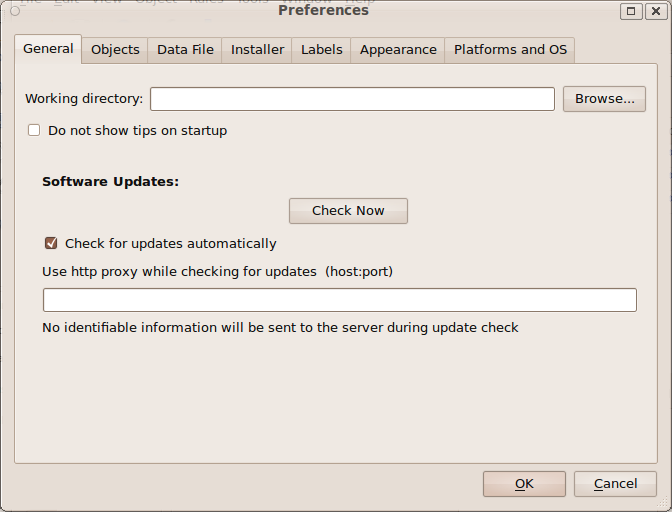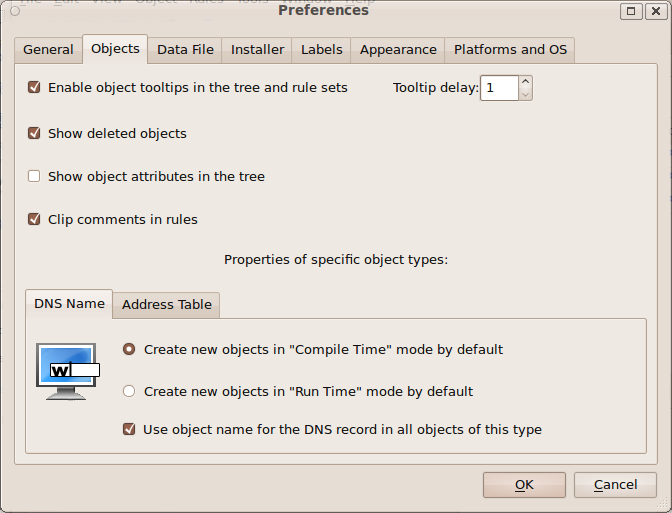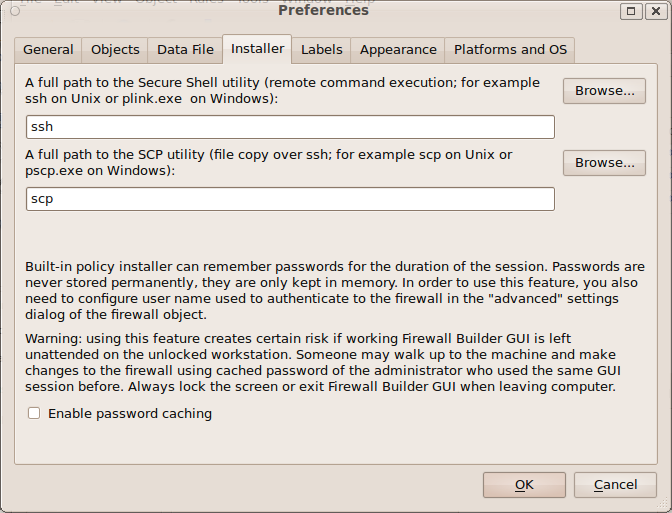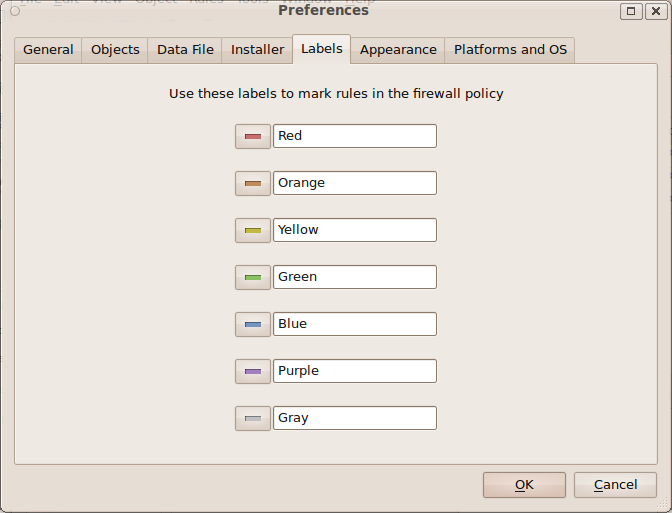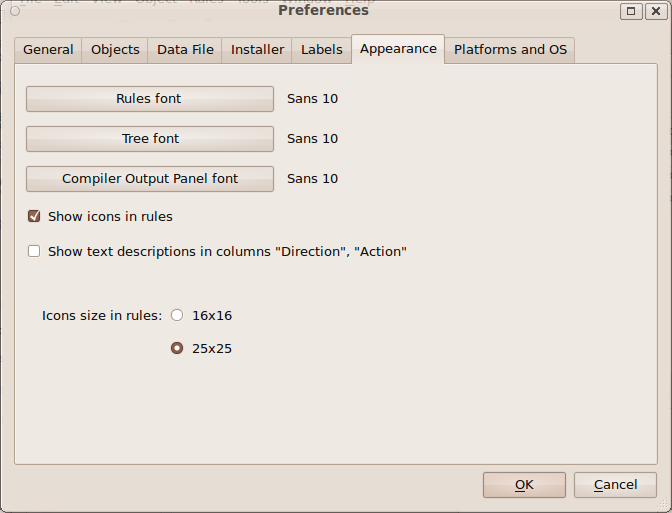Search Users Guide
To open the Preferences dialog, select . The dialog has several tabs, described here.
Table 4.9. Preferences>General Tab
| General Preferences | Explanation |
|---|---|
| Working Directory | This option tells the program where it should store the data file. Policy compilers also store firewall configuration files and scripts they produce in this directory. If this parameter is left blank, the policy compiler stores the firewall configurations it generates in the same directory as the original data file. |
| Do not show tips on startup | If checked, the program does not show tips on start up. |
| Check for updates automatically | If checked, the program checks for program updates every time it starts. If unchecked, the program will not chec k for updates unless specifically enabled by clicking the button. |
| Check Now | Click if you want the program to check for updates at that moment. |
| Use http proxy while checking for updates (host:port) | Whether you use the automatic or manual method to check for updates, if you are behind a proxy, enter the host IP and port of the proxy in this field. Separate the host IP and port number with a colon (:). |
Table 4.10. Preferences>Objects Tab
| Objects Preferences | Explanation |
|---|---|
| Enable object tooltips | Firewall Builder can show a summary of an object's properties in a quick pop-up window (a "tooltip") when you hover the mouse cursor over an object icon. If this feature is not enabled, then you must click on an object to get the same information. The Tooltip delay control sets the delay, in seconds, between the time you hover the cursor and the time the tooltip appears. |
| Show deleted objects | Selecting this checkbox turns on a third object tree: Deleted Objects. Once enabled, the Deleted Objects tree acts like trash can (or recycle bin) for deleted objects. If you delete something by mistake, you can retrieve it. |
| Show object attributes in the tree | Creates a second column in the object tree. The second column contains information about the object, such as how many objects a folder contains, whether a rule set is the top rule set , IP addresses, and so on. See Section 4.3.3 for a description. |
| Clip comments in rules | Comments in a rule can sometimes make the rule line taller, reducing the number of rules visible on a screen. Select this if you want comments to be truncated in the view if they take up more than one line. |
| DNS Name - Create new objects in "Compile Time" or "Run Time" mode by default | These radio buttons set the default behavior for reading DNS Name object addresses from a file: when the firewall script is generated by Firewall Builder or when the firewall runs the script. Note that the default value set here can be overridden for individual objects. Section 5.2.16 has more information on DNS Name object creation. |
| DNS Name - Use object name for the DNS record in all objects of this type | If checked, Firewall Builder uses the DNS Name object's name for DNS lookups. If not checked, Firewall Builder uses the DNS Record field in the object for lookups. (If this checkbox is checked, the DNS Record field will be grayed out in all DNS Name objects.) |
| Address Table - Create new objects in "Compile Time" mode or "Run Time" mode by default radio buttons | These radio buttons set the default behavior for reading Address Table object addresses are read from a file: when the firewall script is generated by Firewall Builder or when the firewall runs the script. Note that the default value set here can be overridden for individual objects. Section 5.2.14 has more information on Address Table object creation. |
Table 4.11. Preferences>Data File tab
| Data File Preferences | Explanation |
|---|---|
| Periodically save data to file every ... minute | If checked, data is automatically saved at the specified interval. |
| Do not ask for the log record when checking in the new file version | Affects only RCS. If selected, the system does not prompt you for a "comment" when you check your file back into RCS. See Section 7.7 for a detailed explanation on using revision control with Firewall Builder. |
| Enable compression of the data file | If selected, the data file is compressed to save disk space. |
Table 4.12. Preferences>Installer Tab
| Installer Preferences | Explanation |
|---|---|
| SSH and SCP paths | These fields specify the paths to your SSH and SCP programs, or their equivalents. If these paths are already recorded in your PATH system variable, you need not specify paths here. On Windows, however, you must install putty. See Section 10.5.3 for instructions. |
| Enable password caching | If checked, the program can remember firewall passwords for the duration of the Firewall Builder GUI session. Passwords are never stored permanently in any form; they are only kept in memory for the working Firewall Builder GUI instance. You need to enter each password once when you activate a generated policy. If you keep the program open and need to modify and activate policy again, the password fields in the installer dialog can be filled automatically. Cached passwords are associated with the firewall object and account name used to activate the policy. To use this feature, you must also configure a user name in the Installer tab in the Firewall Settings dialog of the firewall object. Caution: using this feature creates a risk if a working Firewall Builder GUI is left unattended on an unlocked workstation. |
Table 4.13. Preferences>Labels Tab
| Labels Preferences | Explanation |
|---|---|
| Labels | You can assign colors to particular rows in your policies to make them stand out visually. You can also change the text label associated with each color using this tab. While the color shows up in the rule set, the text label only appears in the label list. |
Table 4.14. Preferences>Appearance Tab
| Appearance Preferences | Explanation |
|---|---|
| Rules, Tree, and Compiler Output Panel Fonts | Use these controls to set the font used for rules, the object tree, and the compiler output panel. |
| Show icons in rules | If deselected, suppresses icon display for an object, showing only text. By default, objects such as interfaces, hosts, and networks are displayed as both an icon and text. |
| Show text descriptions in columns "Direction","Action" | If selected, displays text descriptions in addition to icons in the Direction and Action columns. By default, only icons are shown. |
| Icon size | By default, icons are 25x25 pixels. Select 16x16 to make them somewhat smaller. (The larger icons are easier to see, but the smaller ones are useful for smaller displays, such as laptop screens.) |
Table 4.15. Preferences>Platforms and OS Tab
| Platforms and OS Preferences | Explanation |
|---|---|
| Lists of Platforms and OSs | Checked platforms and OSs appear in drop-down menus of platforms and OSs in the program. You can uncheck unneeded platforms and OSs to reduce clutter in GUI menus. Remember to recheck entries when you want them to reappear in the GUI, such as when you acquire a new type of firewall. Also, not all platforms and OSs supported by Firewall Builder are checked by default. If the firewall you have doesn't appear in your drop-down menus, make sure it is checked in this tab. |
Copyright © 2000-2012 NetCitadel, Inc. All rights reserved.
Using free CSS Templates.

